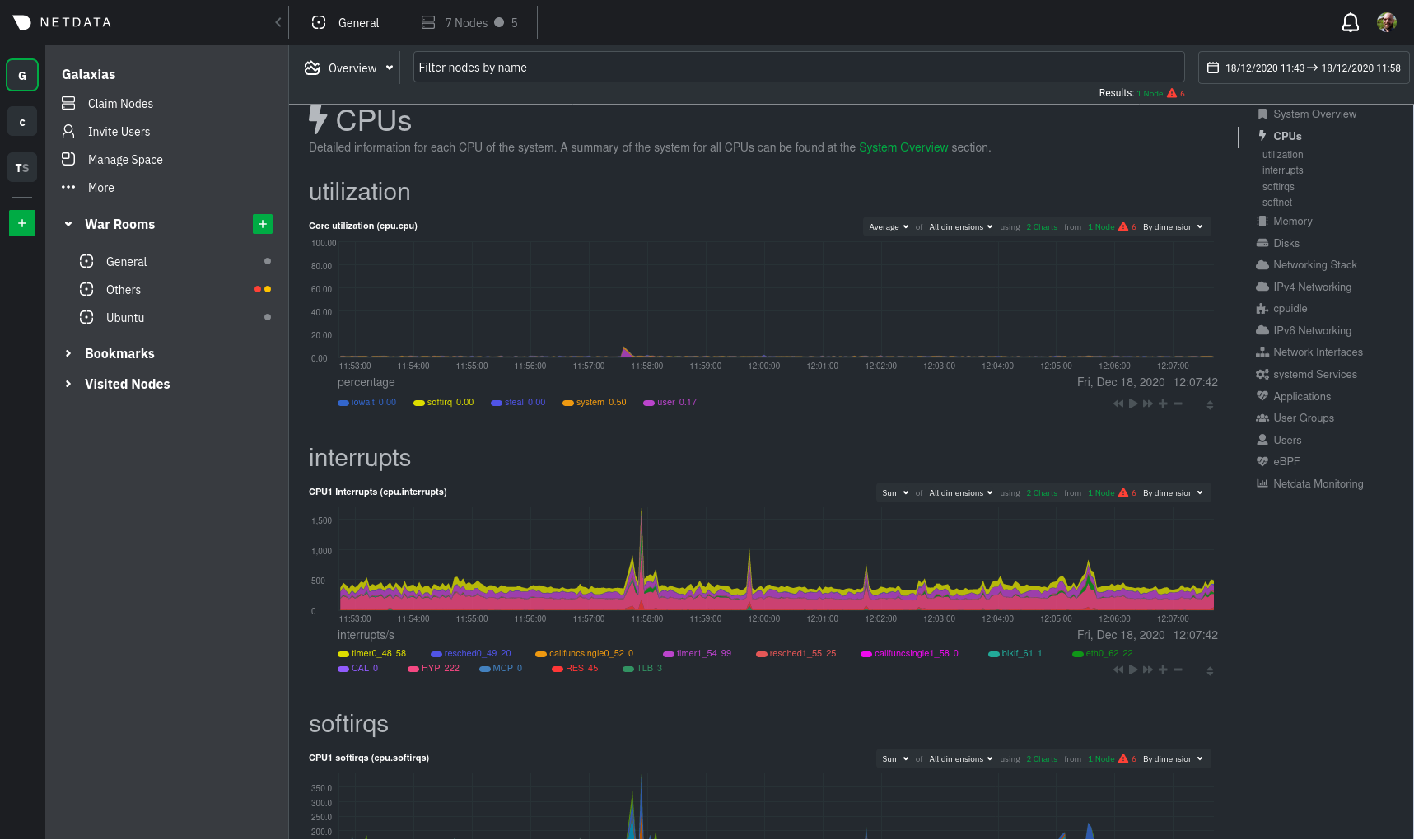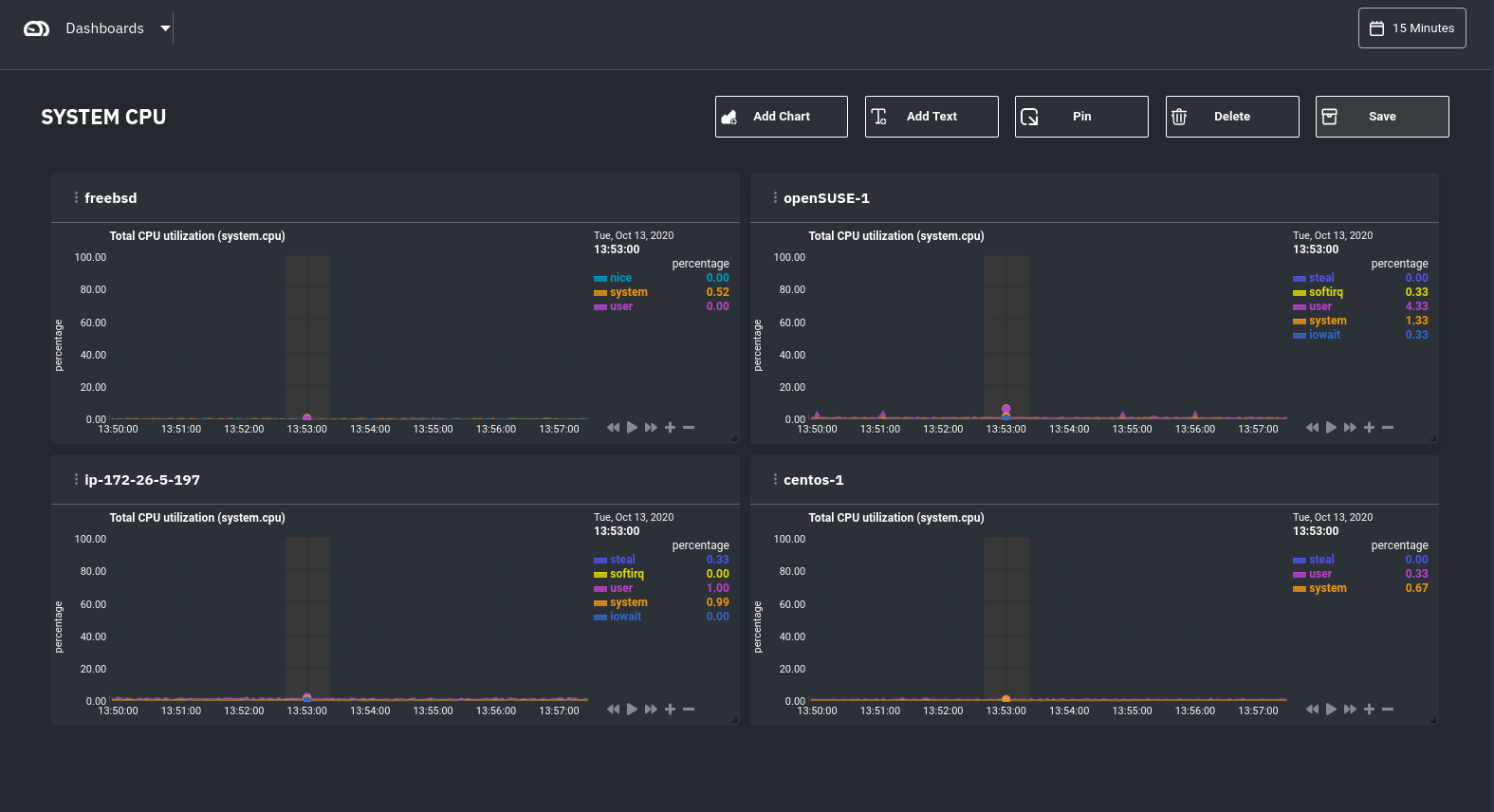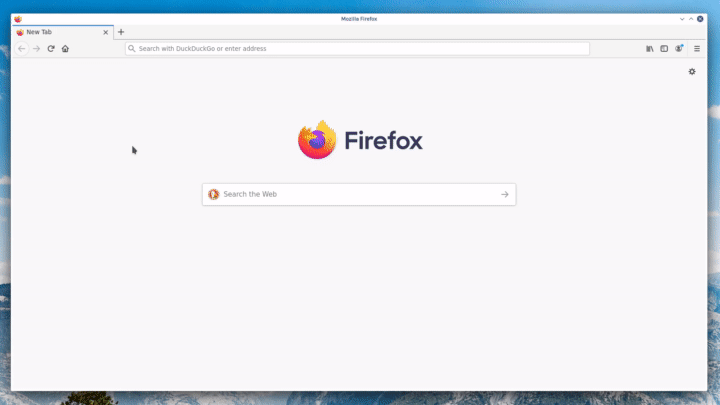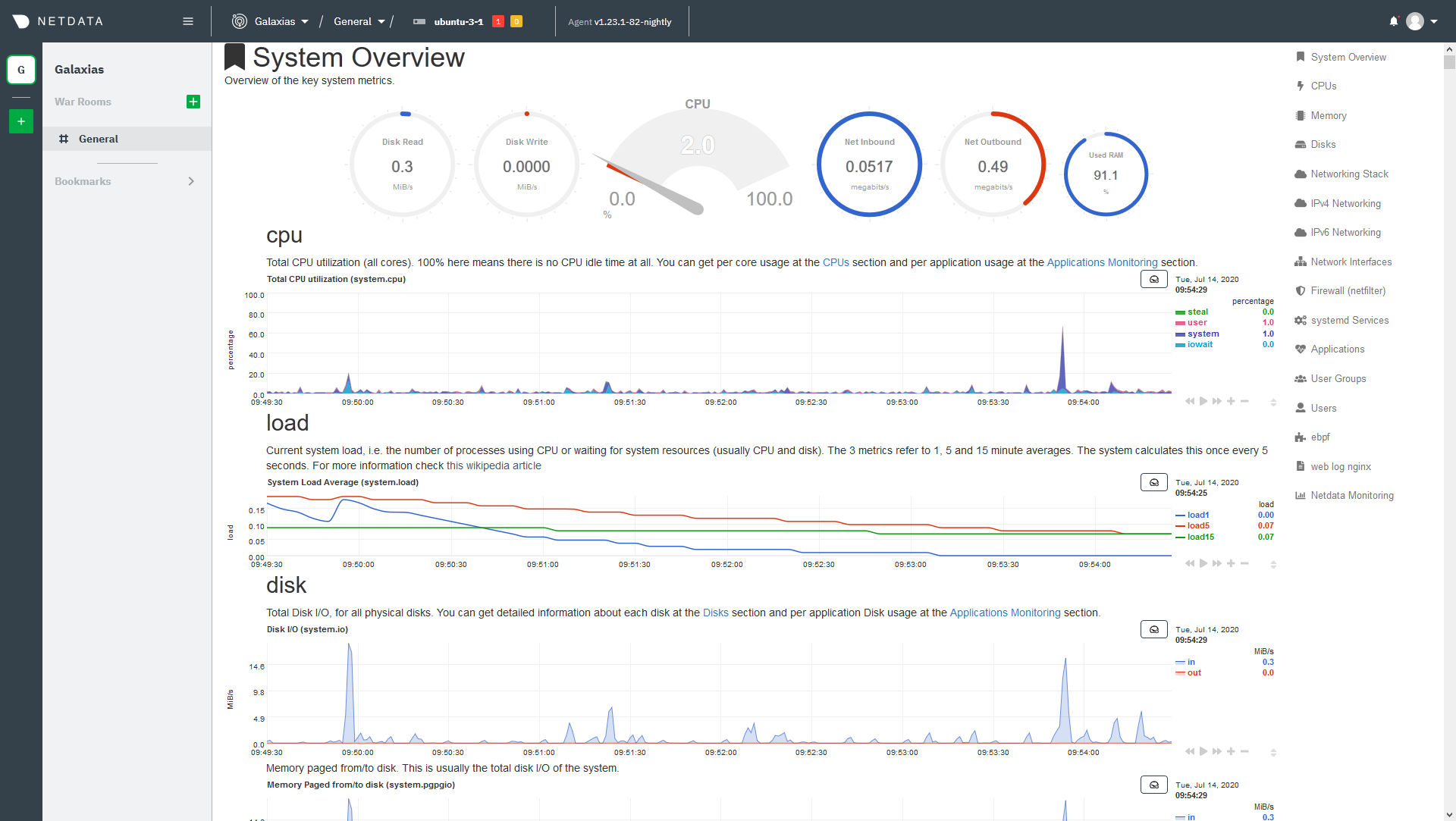diff options
| author | Daniel Baumann <daniel.baumann@progress-linux.org> | 2021-02-07 11:45:55 +0000 |
|---|---|---|
| committer | Daniel Baumann <daniel.baumann@progress-linux.org> | 2021-02-07 11:45:55 +0000 |
| commit | a8220ab2d293bb7f4b014b79d16b2fb05090fa93 (patch) | |
| tree | 77f0a30f016c0925cf7ee9292e644bba183c2774 /docs/quickstart | |
| parent | Adding upstream version 1.19.0. (diff) | |
| download | netdata-a8220ab2d293bb7f4b014b79d16b2fb05090fa93.tar.xz netdata-a8220ab2d293bb7f4b014b79d16b2fb05090fa93.zip | |
Adding upstream version 1.29.0.upstream/1.29.0
Signed-off-by: Daniel Baumann <daniel.baumann@progress-linux.org>
Diffstat (limited to 'docs/quickstart')
| -rw-r--r-- | docs/quickstart/infrastructure.md | 184 | ||||
| -rw-r--r-- | docs/quickstart/single-node.md | 96 |
2 files changed, 280 insertions, 0 deletions
diff --git a/docs/quickstart/infrastructure.md b/docs/quickstart/infrastructure.md new file mode 100644 index 000000000..0e355f373 --- /dev/null +++ b/docs/quickstart/infrastructure.md @@ -0,0 +1,184 @@ +<!-- +title: "Infrastructure monitoring with Netdata" +sidebar_label: "Infrastructure monitoring" +description: "Build a robust, infinitely scalable infrastructure monitoring solution with Netdata. Any number of nodes and every available metric." +custom_edit_url: https://github.com/netdata/netdata/edit/master/docs/quickstart/infrastructure.md +--> + +# Infrastructure monitoring with Netdata + +[Netdata Cloud](https://app.netdata.cloud) provides scalable infrastructure monitoring for any number of distributed +nodes running the Netdata Agent. A node is any system in your infrastructure that you want to monitor, whether it's a +physical or virtual machine (VM), container, cloud deployment, or edge/IoT device. + +The Netdata Agent uses zero-configuration collectors to gather metrics from every application and container instantly, +and uses Netdata's [distributed data architecture](/docs/store/distributed-data-architecture.md) to store metrics +locally. Without a slow and troublesome centralized data lake for your infrastructure's metrics, you reduce the +resources you need to invest in, and the complexity of, monitoring your infrastructure. + +Netdata Cloud unifies infrastructure monitoring by _centralizing the interface_ you use to query and visualize your +nodes' metrics, not the data. By streaming metrics values to your browser, with Netdata Cloud acting as the secure proxy +between them, you can monitor your infrastructure using customizable, interactive, and real-time visualizations from any +numbe of distributed nodes. + +In this quickstart guide, you'll learn the basics of using Netdata Cloud to monitor an infrastructure with dashboards, +composite charts, and alarm viewing. You'll then learn about the most critical ways to configure the Agent on each of +your nodes to maximize the value you get from Netdata. + +This quickstart assumes you've installed the Netdata Agent on more than one node in your infrastructure, and claimed +those nodes to your Space in Netdata Cloud. If you haven't yet, see the [_Get Netdata_ doc](/docs/get/README.md) for +details on signing up for Netdata Cloud, installation, and claiming. + +> If you want to monitor a Kubernetes cluster with Netdata, see our [k8s installation +> doc](/packaging/installer/methods/kubernetes.md) for setup details, and then read our guide, [_Monitor a Kubernetes +> cluster with Netdata_](/docs/guides/monitor/kubernetes-k8s-netdata.md). + +## Set up your Netdata Cloud experience + +Start your infrastructure monitoring experience by setting up your Netdata Cloud account. + +### Organize Spaces and War Rooms + +Spaces are high-level containers to help you organize your team members and the nodes they can view in each War Room. +You already have at least one Space in your Netdata Cloud account. + +A single Space puts all your metrics in one easily-accessible place, while multiple Spaces creates logical division +between different users and different pieces of a large infrastructure. For example, a large organization might have one +SRE team for the user-facing SaaS application, and a second IT team for managing employees' hardware. Since these teams +don't monitor the same nodes, they can work in separate Spaces and then further organize their nodes into War Rooms. + +Next, set up War Rooms. Netdata Cloud creates dashboards and visualizations based on the nodes added to a given War +Room. You can [organize War Rooms](https://learn.netdata.cloud/docs/cloud/war-rooms#war-room-organization) in any way +you want, such as by the application type, for end-to-end application monitoring, or as an incident response tool. + +Learn more about [Spaces](https://learn.netdata.cloud/docs/cloud/spaces) and [War +Rooms](https://learn.netdata.cloud/docs/cloud/war-rooms), including how to manage each, in their respective reference +documentation. + +### Invite your team + +Netdata Cloud makes an infrastructure's real-time metrics available and actionable to all organization members. By +inviting others, you can better synchronize with your team or colleagues to understand your infrastructure's heartbeat. +When something goes wrong, you'll be ready to collaboratively troubleshoot complex performance problems from a single +pane of glass. + +To invite new users, click on **Invite Users** in the left-hand navigation panel beneath your Space's name. Choose which +War Rooms to add this user to, then click **Send**. + +If your team members have trouble signing in, direct them to the [Netdata Cloud sign +in](https://learn.netdata.cloud/docs/cloud/manage/sign-in) doc. + +### See an overview of your infrastructure + +The default way to visualize the health and performance of an infrastructure with Netdata Cloud is the +[**Overview**](/docs/visualize/overview-infrastructure.md), which is the default interface of every War Room. The +Overview features composite charts, which display aggregated metrics from every node in a given War Room. These metrics +are streamed on-demand from individual nodes and composited onto a single, familiar dashboard. + + + +Read more about the Overview in the [infrastructure overview](/docs/visualize/overview-infrastructure.md) doc. + +Netdata Cloud also features the [**Nodes view**](https://learn.netdata.cloud/docs/cloud/visualize/nodes), which you can +use to configure and see a few key metrics from every node in the War Room, view health status, and more. + +### Drill down to specific nodes + +Both the Overview and Nodes view offer easy access to **single-node dashboards** for targeted analysis. You can use +single-node dashboards in Netdata Cloud to drill down on specific issues, scrub backward in time to investigate +historical data, and see like metrics presented meaningfully to help you troubleshoot performance problems. + +Read about the process in the [infrastructure +overview](/docs/visualize/overview-infrastructure.md#single-node-dashboards) doc, then learn about [interacting with +dashboards and charts](/docs/visualize/interact-dashboards-charts.md) to get the most from all of Netdata's real-time +metrics. + +### Create new dashboards + +You can use Netdata Cloud to create new dashboards that match your infrastructure's topology or help you diagnose +complex issues by aggregating correlated charts from any number of nodes. For example, you could monitor the system CPU +from every node in your infrastructure on a single dashboard. + + + +Read more about [creating new dashboards](/docs/visualize/create-dashboards.md) for more details about the process and +additional tips on best leveraging the feature to help you troubleshoot complex performance problems. + +## Set up your nodes + +You get the most value out of Netdata Cloud's infrastructure monitoring capabilities if each node collects every +possible metric. For example, if a node in your infrastructure is responsible for serving a MySQL database, you should +ensure that the Netdata Agent on that node is properly collecting and streaming all MySQL-related metrics. + +In most cases, collectors autodetect their data source and require no configuration, but you may need to configure +certain behaviors based on your infrastructure. Or, you may want to enable/configure advanced functionality, such as +longer metrics retention or streaming. + +### Configure the Netdata Agent on your nodes + +You can configure any node in your infrastructure if you need to, although most users will find the default settings +work extremely well for monitoring their infrastructures. + +Each node has a configuration file called `netdata.conf`, which is typically at `/etc/netdata/netdata.conf`. The best +way to edit this file is using the `edit-config` script, which ensures updates to the Netdata Agent do not overwrite +your changes. For example: + +```bash +cd /etc/netdata +sudo ./edit-config netdata.conf +``` + +Our [configuration basics doc](/docs/configure/nodes.md) contains more information about `netdata.conf`, `edit-config`, +along with simple examples to get you familiar with editing your node's configuration. + +After you've learned the basics, you should [secure your infrastructure's nodes](/docs/configure/secure-nodes.md) using +one of our recommended methods. These security best practices ensure no untrusted parties gain access to the metrics +collected on any of your nodes. + +### Collect metrics from systems and applications + +Netdata has [300+ pre-installed collectors](/collectors/COLLECTORS.md) that gather thousands of metrics with zero +configuration. Collectors search each of your nodes in default locations and ports to find running applications and +gather as many metrics as they can without you having to configure them individually. + +Most collectors work without configuration, but you should read up on [how collectors +work](/docs/collect/how-collectors-work.md) and [how to enable/configure](/docs/collect/enable-configure.md) them so +that you can see metrics from those applications in Netdata Cloud. + +In addition, find detailed information about which [system](/docs/collect/system-metrics.md), +[container](/docs/collect/container-metrics.md), and [application](/docs/collect/application-metrics.md) metrics you can +collect from across your infrastructure with Netdata. + +## What's next? + +Netdata has many features that help you monitor the health of your nodes and troubleshoot complex performance problems. +Once you have a handle on configuration and are collecting all the right metrics, try out some of Netdata's other +infrastructure-focused features: + +- [See an overview of your infrastructure](/docs/visualize/overview-infrastructure.md) using Netdata Cloud's composite + charts and real-time visualizations. +- [Create new dashboards](/docs/visualize/create-dashboards.md) from any number of nodes and metrics in Netdata Cloud. + +To change how the Netdata Agent runs on each node, dig in to configuration files: + +- [Change how long nodes in your infrastructure retain metrics](/docs/store/change-metrics-storage.md) based on how + many metrics each node collects, your preferred retention period, and the resources you want to dedicate toward + long-term metrics retention. +- [Create new alarms](/docs/monitor/configure-alarms.md), or tweak some of the pre-configured alarms, to stay on top + of anomalies. +- [Enable notifications](/docs/monitor/enable-notifications.md) to Slack, PagerDuty, email, and 30+ other services. +- [Export metrics](/docs/export/external-databases.md) to an external time-series database to use Netdata alongside + other monitoring and troubleshooting tools. + +### Related reference documentation + +- [Netdata Cloud · Spaces](https://learn.netdata.cloud/docs/cloud/spaces) +- [Netdata Cloud · War Rooms](https://learn.netdata.cloud/docs/cloud/war-rooms) +- [Netdata Cloud · Invite your team](https://learn.netdata.cloud/docs/cloud/manage/invite-your-team) +- [Netdata Cloud · Sign in or sign up with email, Google, or + GitHub](https://learn.netdata.cloud/docs/cloud/manage/sign-in) +- [Netdata Cloud · Nodes view](https://learn.netdata.cloud/docs/cloud/visualize/nodes) + +[](<>) diff --git a/docs/quickstart/single-node.md b/docs/quickstart/single-node.md new file mode 100644 index 000000000..77656af26 --- /dev/null +++ b/docs/quickstart/single-node.md @@ -0,0 +1,96 @@ +<!-- +title: "Single-node monitoring with Netdata" +sidebar_label: "Single-node monitoring" +description: "Learn dashboard basics, configuring your nodes, and collecting metrics from applications to create a powerful single-node monitoring tool." +custom_edit_url: https://github.com/netdata/netdata/edit/master/docs/quickstart/single-node.md +--> + +# Single-node monitoring with Netdata + +Because it's free, open-source, and requires only 1% CPU utilization to collect thousands of metrics every second, +Netdata is a superb single-node monitoring tool. + +In this quickstart guide, you'll learn how to access your single node's metrics through dashboards, configure your node +to your liking, and make sure the Netdata Agent is collecting metrics from the applications or containers you're running +on your node. + +> This quickstart assumes you have installed the Netdata Agent on your node. If you haven't yet, see the [_Get Netdata_ +> doc](/docs/get/README.md) for details on installation. In addition, this quickstart mentions features available only +> through Netdata Cloud, which requires you to [claim your node](/docs/get/README.md#claim-your-node-on-netdata-cloud). + +## See your node's metrics + +To see your node's real-time metrics, you need to access its dashboard. You can either view the local dashboard, which +runs on the node itself, or see the dashboard through Netdata Cloud. Both methods feature real-time, interactive, and +synchronized charts, with the same metrics, and use the same UI. + +The primary difference is that Netdata Cloud also has a few extra features, like creating new dashboards using a +drag-and-drop editor, that enhance your monitoring and troubleshooting experience. + +To see your node's local dashboard, open up your web browser of choice and navigate to `http://NODE:19999`, replacing +`NODE` with the IP address or hostname of your Agent. Hit `Enter`. + + + +To see a node's dashboard in Netdata Cloud, [sign in](https://app.netdata.cloud). From the **Nodes** view in your +**General** War Room, click on the hostname of your node to access its dashboard through Netdata Cloud. + + + +Once you've decided which dashboard you prefer, learn about [interacting with dashboards and +charts](/docs/visualize/interact-dashboards-charts.md) to get the most from Netdata's real-time metrics. + +## Configure your node + +The Netdata Agent is highly configurable so that you can match its behavior to your node. You will find most +configuration options in the `netdata.conf` file, which is typically at `/etc/netdata/netdata.conf`. The best way to +edit this file is using the `edit-config` script, which ensures updates to the Netdata Agent do not overwrite your +changes. For example: + +```bash +cd /etc/netdata +sudo ./edit-config netdata.conf +``` + +Our [configuration basics doc](/docs/configure/nodes.md) contains more information about `netdata.conf`, `edit-config`, +along with simple examples to get you familiar with editing your node's configuration. + +After you've learned the basics, you should [secure your node](/docs/configure/secure-nodes.md) using one of our +recommended methods. These security best practices ensure no untrusted parties gain access to your dashboard or its +metrics. + +## Collect metrics from your system and applications + +Netdata has [300+ pre-installed collectors](/collectors/COLLECTORS.md) that gather thousands of metrics with zero +configuration. Collectors search your node in default locations and ports to find running applications and gather as +many metrics as possible without you having to configure them individually. + +These metrics enrich both the local and Netdata Cloud dashboards. + +Most collectors work without configuration, but you should read up on [how collectors +work](/docs/collect/how-collectors-work.md) and [how to enable/configure](/docs/collect/enable-configure.md) them. + +In addition, find detailed information about which [system](/docs/collect/system-metrics.md), +[container](/docs/collect/container-metrics.md), and [application](/docs/collect/application-metrics.md) metrics you can +collect from across your infrastructure with Netdata. + +## What's next? + +Netdata has many features that help you monitor the health of your node and troubleshoot complex performance problems. +Once you understand configuration, and are certain Netdata is collecting all the important metrics from your node, try +out some of Netdata's other visualization and health monitoring features: + +- [Build new dashboards](/docs/visualize/create-dashboards.md) to put disparate but relevant metrics onto a single + interface. +- [Create new alarms](/docs/monitor/configure-alarms.md), or tweak some of the pre-configured alarms, to stay on top + of anomalies. +- [Enable notifications](/docs/monitor/enable-notifications.md) to Slack, PagerDuty, email, and 30+ other services. +- [Change how long your node stores metrics](/docs/store/change-metrics-storage.md) based on how many metrics it + collects, your preferred retention period, and the resources you want to dedicate toward long-term metrics + retention. +- [Export metrics](/docs/export/external-databases.md) to an external time-series database to use Netdata alongside + other monitoring and troubleshooting tools. + +[](<>) |
